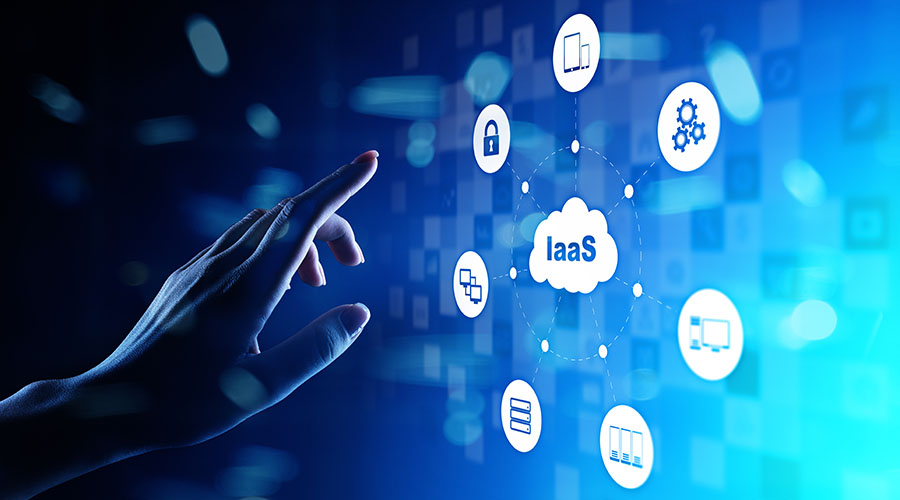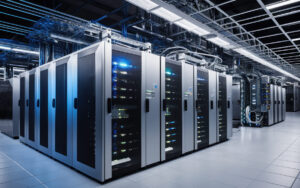Whether we’re talking about private, public, or hybrid cloud technologies, cloud computing offers a versatile range of virtual services for any size organization and the private consumer. This article explores Infrastructure-as-a-Platform or IaaS for short.
We will discuss what IaaS is, how it works, the pros and cons, IaaS implementation and application, how it stacks up to other cloud services, pricing, and an opportunity for you to learn how to upskill on the key elements of cloud services for a better career.
We start things off with a basic definition.
What is IaaS?
Companies just starting to implement cloud computing typically start with IaaS. As the name implies, Infrastructure-as-a-Service manages an organization’s infrastructure through the Internet and features services such as data storage, servers, networks, and virtualization. Users access these resources via dashboards or APIs. The client runs and manages their applications, middleware, and operating systems, while the provider is responsible for the hardware, data storage, networking, hard drives, and servers. The provider is also responsible for resolving repairs, outages, and hardware problems. So, the company rents an entire virtual IT infrastructure. Examples of IaaS include AWS EC2 Instance, the Azure Virtual Machine, and Google Cloud VM Instance (Google Compute Engine).
IaaS infrastructure as a service is an excellent choice for a company that wants to have a vast multinational conglomerate’s processing and storage power for a fraction of the cost. Why bother to buy and maintain IT resources onsite when a business can pay an IaaS cloud service provider to do it for less money and hassle?
Also Read: How to Become a Cloud Engineer?
How Does IaaS Work? A Look at IaaS Architecture
We continue our look at IaaS in cloud computing by examining its workings and architecture. IaaS consists of physical and virtualized resources that give customers the basic building blocks to run cloud applications. IaaS consists of the following:
- The physical data centers. IaaS providers manage large data centers worldwide. These centers contain physical machines required for IaaS. Typically, end users don’t interact directly with IaaS’s physical infrastructure.
- Compute. IaaS compute is a virtual machine. Providers manage the hypervisors, and clients can programmatically provision virtual “instances,” complete with the desired quantity of compute, memory, and storage resources. Most cloud providers offer both CPUs and GPUs, depending on the workload requirements. In addition, cloud compute usually comes paired with supporting services such as load balancing and auto-scaling, providing the scale and performance characteristics customers look for from the cloud.
- Network. Cloud networking is software-defined networking where traditional networking hardware (e.g., routers and switches) is made available programmatically, usually via APIs. In more advanced networking, cloud providers use multi-zone regions and virtual private clouds.
- Storage. The three main types of cloud storage are file storage, block storage, and object storage. Block and file storage are typically found in traditional data centers, although they often have issues with scale, performance, and distributed cloud characteristics. As a result, object storage has become the most common cloud storage since it is highly distributed and thus has more excellent resiliency. In addition, object storage leverages commodity hardware, allows easy data access over HTTP, and offers a limitless scale.
The Advantages of IaaS
The IaaS cloud service offers many advantages to businesses of all sizes, from giant corporations to one-person home businesses.
- It’s pay-as-you-go. Unlike traditional IT, customers using IaaS don’t need to pay any up-front starter costs, and end users are only billed for what they use.
- It’s fast. Customers using IaaS can provision small or vast amounts of resources in minutes.
- It’s readily available. Cloud applications’ availability and resiliency can surpass traditional approaches thanks to features like multi-zone regions.
- It’s easily scalable. It’s easy to go from a single instance of an application to multiple cases, thanks to the ability to scale resources and the seemingly limitless capacity.
- It offers lower latency and more remarkable performance. Due to the broad geographic footprint of many IaaS providers, it’s easy to put apps and services closers to end users, thereby reducing latency and increasing performance.
The Disadvantages of IaaS
Conversely, there are a few drawbacks to IaaS in cloud computing.
- Billing issues. Although IaaS uses a flexible, pay-as-you-go model, some businesses have issues with IaaS billing. Cloud billing is very granular, broken out to reflect exact service usage. Thus, it’s common for users to experience sticker shock. To remedy this, users should closely monitor IaaS environments and bills to understand their IaaS is being used and avoid getting charged for unauthorized services.
- Lack of transparency. Since IaaS providers own the infrastructure, IaaS users typically can’t see characteristics like infrastructure configuration and performance. This lack of transparency can pose challenges for systems management and monitoring.
- Resilience issues. The workload’s availability and performance rely on the provider. If the IaaS provider is experiencing network bottlenecks or internal or external downtime, it will affect the user’s workload. Additionally, IaaS is a multi-tenant architecture, so the “noisy neighbor” syndrome can negatively impact the user’s workload.
How Do You Implement IaaS?
So, how does a business implement IaaS cloud technology? There are important considerations to address before an organization implements IaaS. First, the company, and its skilled cloud practitioners, need to strictly define IaaS use cases and infrastructure needs before considering the different technical requirements and providers. The technical and storage needs to be considered include:
- Networking. Can the provisioned infrastructure be accessed efficiently?
- Storage. What are your requirements for storage types, storage performance levels, needed space, provisioning, and potential options like object storage?
- Compute. Has your organization considered the different servers, VM, CPU, and memory options various cloud providers offer and what it means to the company?
- Security. The organization must ask detailed questions about certifications, data encryption, compliance and regulation, and secure workloads.
- Disaster recovery. What disaster recovery features and options does the provider offer in the event of failover on server, VM, or site levels?
- Server Size. What are the server and VM size options? How many CPUs can you place on the servers?
- Network throughput. What are the speeds between data centers, VMs, storage, and the Internet?
- Overall manageability. How many IaaS features does the user control, which IaaS parts do the customer need to control, and how easy is it to control and manage these components?
The IaaS vendor market must be carefully weighed and evaluated. Since product capabilities can vary greatly, some may better mesh with your business needs than others.
Once you choose a vendor and specific product, it’s essential to negotiate any relevant service-level agreements (SLAs).
Additionally, the organization should thoroughly assess its IT department’s capabilities to determine how well it can handle the ongoing demands of IaaS implementation. In IaaS models, the in-house developers are responsible for the infrastructure’s technical maintenance (e.g., software patches, upgrades, and troubleshooting).
Also Read: Cloud Computing Technology: Your Complete Guide
IaaS vs. BMaaS
So what’s the difference between IaaS cloud technology and BMaaS? What’s BMaaS anyway? It stands for Bare Metal as a Service. In a BMaaS environment, like IaaS, resources are still provisioned on-demand, accessed over the Internet, and billed on a pay-as-you-go basis.
However, BMaaS doesn’t provide end users with already virtualized compute, network, and storage. Instead, BMaaS provides the client with direct access to the underlying hardware, giving end users nearly total control of their specs. In other words, customers get the bare bones (or bare metal in this case!). Furthermore, since the hardware is neither virtualized nor supports multiple virtual machines, end users acquire the most significant amount of potential performance, something valuable for high-performance databases, HPC and GPU computing, analytics workloads, and others.
IaaS vs. PaaS vs. SaaS
So what’s the difference between Infrastructure-as-a-Service, Platform-as-a-Service, and Software-as-a-Service? IaaS gives users chosen levels of control over the infrastructure. PaaS users don’t have to manage the runtime, operating system, or other infrastructural components. SaaS is a software delivery model where third-party vendors offer users a software application over the Internet. These applications are usually built inside a cloud infrastructure and accessed from anywhere with Internet access.
IaaS vs. Containers vs. Serverless
Containers and serverless computing are two new cloud models challenging traditional IaaS models for supremacy in particular classes of cloud-native workloads and applications. In some quarters, containers have started to replace VMs as the standard unit of service or process deployment, with orchestration tools such as Kubernetes controlling the entire ecosystem of clusters.
Serverless goes the furthest of any cloud model. It abstracts almost everything, but the business logic scales perfectly with demand and comes the closest to fulfilling the promise of paying only for what the customer uses.
Virtual Private Cloud and IaaS
VPCs let end users create a private network for a single tenant in the public cloud. VPCs give users control of IP address range selection, load balancing, subnet creation, security groups, virtual firewalls, network ACLs, and site-to-site virtual private networks (VPNs). In the context of IaaS, VPC offers an additional layer of security for users working with sensitive data or strict compliance requirements.
IaaS and DevOps
DevOps emphasizes reducing software development times and advancing to deployment so customers can access new high-quality applications faster. DevOps goes hand in hand with frequent code and dynamic infrastructure usage changes, which makes IaaS the perfect choice. IaaS reduces the need to maintain server infrastructure and emphasizes a more direct, automated developer experience, an ideal environment to support DevOps workflows.
The Major IaaS Vendors and Products
There are lots of IaaS-related offerings available for all kinds of organizations and workloads. Here’s a sampling of the more well-known offerings. For starters, let’s list the big three.
- Amazon Web Services (AWS) offers clients storage services like Simple Storage Service (S3) and Glacier, plus compute services like the Elastic Compute Cloud (EC2).
- Google Cloud Platform (GCP) offers customers storage and compute services via its Google Compute Engine.
- Microsoft Azure Virtual Machines offers users cloud virtualization for many different cloud computing purposes.
Services can include serverless functions (e.g., AWS Lambda, Azure Functions, Google Cloud Functions), big data compute environments, database access, logging, monitoring, and more.
There is also other more minor, more niche players in the IaaS marketplace, like:
- Alibaba Elastic Compute Service
- Alibaba Cloud Elastic High Performance Computing (E-HPC)
- Alibaba Elastic GPU Service (EGS)
- CenturyLink Cloud
- DigitalOcean Droplets
- IBM Cloud Private
- IBM Cloud Virtual Servers
- Rackspace Managed Cloud
IaaS Pricing
IaaS services are usually priced on a consumption basis. This model means users only get charged for what they use. Here are the most popular pricing models:
- By the hour/second. Yes, the pricing can get this granular! This pricing model is the most common granularity for typical IaaS cloud infrastructure, and end users get charged only for what they use.
- Monthly billing. Monthly billing models are the most common in the BMaaS market, where the need for a physical infrastructure usually means there will be steady state workloads without spiky characteristics.
- Subscriptions and reserved instances. Many cloud providers offer discounted sticker prices for clients who commit to longer contract terms, usually around one to three years. In other words, the more you buy, the more you save.
- Transient/spot. Some cloud providers offer up discounted unused capacity through transient/spot instances. However, these instances can be reclaimed if the capacity is needed.
Do You Want to Learn How to Work in Cloud Computing?
As more organizations migrate to the cloud, the demand for cloud computing professionals grows. If you want to start a career in cloud computing or upskill your current cloud-related skill set, consider earning a certificate in cloud computing.
By doing so, you can fast-track your career by learning cloud architecture principles with an emphasis on the two most popular cloud platforms today: Amazon Web Services (AWS) and Azure. Additionally, you’ll work on hands-on industry projects designed to help you gain the necessary skills to design, plan, implement, and scale elaborate and complex cloud environments.
This bootcamp gives you valuable, in-demand skills such as:
- Application Migration
- Autoscaling
- Cloud Migration and Deployment
- Cloud Provider Selection
- Cloud Workloads
- Database Management
- Disaster Recovery
- Identity Access Management
- MultiCloud Deployment
- Performance Testing
- Storage Services
- Web Services and API
You will benefit from the bootcamp’s applied learning approach, including more than 40 relevant, hands-on projects, sandboxed labs, and finishing up with a capstone project in four domains.
You might also like to read:
Virtualization in Cloud Computing






